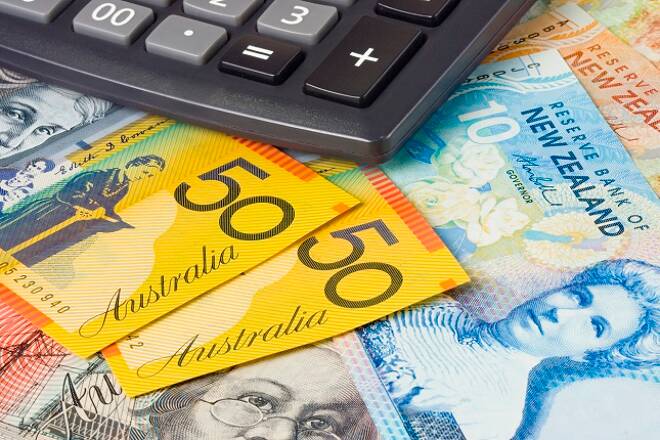Advertisement
Advertisement
AUD/USD and NZD/USD Fundamental Weekly Forecast – Aussie CPI Data May Take Backseat to Geopolitical Turmoil
By:
Aussie and Kiwi investors are going to focus on demand for risk, U.S. Treasury yields and the direction of the U.S. Dollar this week. The catalyst likely to influence these factors is the escalating tension over the trade dispute between the United States and China. Traders are also likely to continue to react to any renewed criticism from Trump on Fed policy and the value of the U.S. Dollar.
The Australian and New Zealand Dollars finished mixed last week with the Australian Dollar posting a small loss and the New Zealand Dollar closing slightly better. The price action was volatile with both currencies posting two-sided moves.
Domestic data did influence the price action in the Aussie for a time. There was nothing out of New Zealand to speak of. The currencies were pressured by hawkish testimony by U.S. Federal Reserve Chairman Jerome Powell and supported by comments from President Trump, who criticized Fed policy and the strength of the U.S. Dollar. Trump also threatened China with additional tariffs.
Last week, the AUD/USD settled at .7418, down 0.0006 or -0.09% and the NZD/USD finished at .6808, up 0.0040 or +0.60%.
U.S. Treasury yields rose after Powell testified about the state of the economy and monetary policy before congressional sub-committees. His comments helped widen the spread between U.S. Government bond yields and Australian and New Zealand Government bond yields. This helped make the U.S. Dollar a more desirable investment.
During his semiannual monetary policy report to Congress, Powell said the economy is strong enough to handle tighter monetary policy. He noted: “Overall, we see the risk of the economy unexpectedly weakening as roughly balanced with the possibility of the economy growing faster than we currently anticipate.” Powell also said growth in the second quarter was “considerably stronger than in the first.”
The AUD/USD and NZD/USD strengthened late in the week after President Trump said he was not thrilled the Fed was raising rates. He told CNBC’s Joe Kernen, “Because we go up and every time you go up they want to raise rates again. I don’t really – I am not happy about it. But at the same time I’m letting them do what they feel is best.”
Trump also went on to attack the rising U.S. Dollar while threatening China with additional tariffs.
Trump followed-up his July 19 comments on Friday by tweeting, “The United States should not be penalized because we are doing so well. Tightening now hurts all that we have done. The U.S. should be allowed to recapture what was lost due to illegal currency manipulation and BAD Trade Deals. Debt coming due & we are raising rates – Really?”
Trump also said he was prepared to place a tariff on everything that China exports to the United States.
In Australia, The Australian Dollar posted a short-lived rally after positive employment data drove short-term domestic bond yields higher, however, the data isn’t likely strong enough to alter the monetary policy of the Reserve Bank of Australia.
The data released earlier in the session showed the Australian economy added 50.9K jobs, a significant jump from the 16.7K forecast and the 13.4K previous reading.
Officially, according to Australia’s Bureau of Statistics (ABS), employment jumped by 50,900 in seasonally adjusted terms, beating the median economist forecast that was looking for an increase of 16,500.
Despite the surge in hiring, the unemployment rate held steady at 5.4%, courtesy of a sharp lift in labor force participation. Without rounding, the unemployment rate now stands at the lowest level since November 2012.
Forecast
Aussie and Kiwi investors are going to focus on demand for risk, U.S. Treasury yields and the direction of the U.S. Dollar this week. The catalyst likely to influence these factors is the escalating tension over the trade dispute between the United States and China. Traders are also likely to continue to react to any renewed criticism from Trump on Fed policy and the value of the U.S. Dollar.
In Australia, the key report is quarterly CPI. It is expected to rise 0.5%, up from 0.4%. Trimmed Mean CPI is also expected to rise 0.5%.
Last week’s unemployment data was strong, but not enough to convince the Reserve Bank of Australia to raise rates sooner than expected. The central bank wants a tightening job market to lead to higher wages. Once wages rise, inflation should follow.
Currently, investors have priced in the next rate hike for about November 2019 or early 2020.
In the U.S., investors will get the opportunity to react to data on Durable Goods and Advance GDP.
About the Author
James Hyerczykauthor
James is a Florida-based technical analyst, market researcher, educator and trader with 35+ years of experience. He is an expert in the area of patterns, price and time analysis as it applies to futures, Forex, and stocks.
Did you find this article useful?
Latest news and analysis
Advertisement
